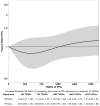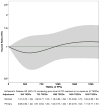Proton Pump Inhibitor Use and Dementia Risk: Prospective Population-Based Study
- PMID: 29134629
- PMCID: PMC5809315
- DOI: 10.1111/jgs.15073
Proton Pump Inhibitor Use and Dementia Risk: Prospective Population-Based Study
Abstract
Objectives: To determine whether higher cumulative proton pump inhibitor (PPI) exposure is associated with greater dementia risk.
Design: Prospective population-based cohort study.
Setting: Kaiser Permanente Washington, an integrated healthcare delivery system in Seattle, Washington.
Participants: Individuals aged 65 and older without dementia at study entry (N = 3,484).
Measurements: Participants were screened for dementia every 2 years, and those who screened positive underwent extensive evaluation. Dementia outcomes were determined using standard diagnostic criteria. Time-varying PPI exposure was determined from computerized pharmacy data and consisted of total standardized daily doses (TSDDs) dispensed to an individual in the prior 10 years. We also assessed duration of use. Multivariable Cox regression was used to estimate the association between PPI exposure and time to dementia or Alzheimer's disease (AD).
Results: Over a mean follow-up of 7.5 years, 827 participants (23.7%) developed dementia (670 with possible or probable AD). PPI exposure was not associated with risk of dementia (P = .66) or AD (P = .77). For dementia, the risk for specific levels of cumulative exposure compared to no use was: 365 TSDDs (HR 0.87, 95% CI 0.65-1.18), 1,095 TSDDs (HR 0.99, CI 0.75-1.30) and 1,825 TSDDs (HR 1.13, CI 0.82-1.56). These TSDD levels represent approximately 1, 3 and 5 years of daily use respectively. Duration of PPI use was not associated with dementia outcomes either.
Conclusion: Proton pump inhibitor use was not associated with dementia risk, even for people with high cumulative exposure. Although there are other safety concerns with long-term PPI use, results from our study do not support that these medications should be avoided out of concern about dementia risk.
Keywords: Alzheimer disease; aged; cohort study; dementia; pharmacoepidemiology; proton pump inhibitor.
© 2017, Copyright the Authors Journal compilation © 2017, The American Geriatrics Society.
Conflict of interest statement
[Table: see text]
Figures


Comment in
-
Proton Pump Inhibitor Therapy and Dementia: What Is the Evidence?J Am Geriatr Soc. 2018 Feb;66(2):224-226. doi: 10.1111/jgs.15171. Epub 2017 Nov 14. J Am Geriatr Soc. 2018. PMID: 29134626 No abstract available.
Similar articles
-
Cumulative Antidepressant Use and Risk of Dementia in a Prospective Cohort Study.J Am Geriatr Soc. 2018 Oct;66(10):1948-1955. doi: 10.1111/jgs.15508. Epub 2018 Sep 17. J Am Geriatr Soc. 2018. PMID: 30221747
-
Benzodiazepine use and risk of incident dementia or cognitive decline: prospective population based study.BMJ. 2016 Feb 2;352:i90. doi: 10.1136/bmj.i90. BMJ. 2016. PMID: 26837813 Free PMC article.
-
Cumulative use of strong anticholinergics and incident dementia: a prospective cohort study.JAMA Intern Med. 2015 Mar;175(3):401-7. doi: 10.1001/jamainternmed.2014.7663. JAMA Intern Med. 2015. PMID: 25621434 Free PMC article.
-
Proton pump inhibitors do not increase the risk of dementia: a systematic review and meta-analysis of prospective studies.Dis Esophagus. 2020 Oct 12;33(10):doaa041. doi: 10.1093/dote/doaa041. Dis Esophagus. 2020. PMID: 32476013
-
Proton pump inhibitor use and risk of dementia: Systematic review and meta-analysis.Medicine (Baltimore). 2019 Feb;98(7):e14422. doi: 10.1097/MD.0000000000014422. Medicine (Baltimore). 2019. PMID: 30762748 Free PMC article.
Cited by
-
Proton Pump Inhibitor Use and Risk of Developing Alzheimer's Disease or Vascular Dementia: A Case-Control Analysis.Drug Saf. 2018 Dec;41(12):1387-1396. doi: 10.1007/s40264-018-0704-9. Drug Saf. 2018. PMID: 30146658
-
Increased risk of death associated with the use of proton-pump inhibitors in patients with dementia and controls - a pharmacoepidemiological claims data analysis.Eur J Neurol. 2020 Aug;27(8):1422-1428. doi: 10.1111/ene.14252. Epub 2020 May 6. Eur J Neurol. 2020. PMID: 32281706 Free PMC article.
-
Regular proton pump inhibitor use and incident dementia: population-based cohort study.BMC Med. 2022 Sep 1;20(1):271. doi: 10.1186/s12916-022-02478-y. BMC Med. 2022. PMID: 36045363 Free PMC article.
-
Proton Pump Inhibitors and Cognitive Health: Review on Unraveling the Dementia Connection and Co-morbid Risks.Curr Alzheimer Res. 2024;20(11):739-757. doi: 10.2174/0115672050289946240223050737. Curr Alzheimer Res. 2024. PMID: 38424433 Free PMC article. Review.
-
Gastric acid suppressants and cognitive decline in people with or without cognitive impairment.Alzheimers Dement (N Y). 2022 Feb 10;8(1):e12243. doi: 10.1002/trc2.12243. eCollection 2022. Alzheimers Dement (N Y). 2022. PMID: 35169610 Free PMC article.
References
-
- Rane PP, Guha S, Chatterjee S, et al. Prevalence and predictors of non-evidence based proton pump inhibitor use among elderly nursing home residents in the US. Res Social Adm Pharm. 2016 pii: S1551–7411. - PubMed
-
- Heidelbaugh JJ, Goldberg KL, Inadomi JM. Magnitude and economic effect of overuse of antisecretory therapy in the ambulatory care setting. Am J Manag Care. 2010;16(9):e228–234. - PubMed
Publication types
MeSH terms
Substances
Grants and funding
LinkOut - more resources
Full Text Sources
Other Literature Sources
Medical

